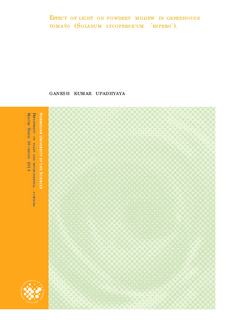| dc.contributor.author | Upadhyaya, Ganesh Kumar | |
| dc.date.accessioned | 2013-07-17T11:23:42Z | |
| dc.date.available | 2013-07-17T11:23:42Z | |
| dc.date.issued | 2013-07-17 | |
| dc.identifier.uri | http://hdl.handle.net/11250/189664 | |
| dc.description.abstract | Powdery mildew caused by Oidium neolycopercisi is one of the most destructive diseases in
greenhouse tomato and has been an increasing problem in Norwegian greenhouse tomato
industry. Due to the favourable environment and the lack of resistance varieties, they are
extremely aggressive in greenhouse tomato. We do not want to use fungicides are frequently
used to treat the tomato for powdery mildew. The most common fungicides are sulphurs. As
we do not want to use these kinds of fungicides because they can be harmful to the human
health and biological control agents, there is a need for alternative preventing measures that
will be economical. Light regulation is one of the possible strategies that can be used in
management of powdery mildew in greenhouse tomato production. In this study, the effect of
light, lighting duration and its intensity on powdery mildew severity of tomato were
examined under growth chamber conditions.
The powdery mildew susceptible tomato plants cv.Espero was inoculated by spraying
conidial suspension prepared from 7-10 days old powdery mildew inoculum. Inoculated
plants were exposed to different light treatment. Among the different lighting treatment
inoculated plants exposed to 16 hours of daily lighting supplied by red light emitting diode
(LEDs) shows significantly low level of severity on inoculated plants as well as no disease in
non-inoculated plants compared to all other treatments. In the combination of HPS and LED,
the powdery mildew severity has no significance after 18 days inoculation. However, tomato
plants exposed to 16 hours of daily red light treatment showed symptoms of leaves in pale
green colour with downward curling. Further total dry weight of above ground plant parts
significantly low in plants grown under red light compared with rest of treatment. The result
showed that the application of only red light has very limited potential in powdery mildew
disease management in practice. Further research in combination with different spectral quality is necessary. | no_NO |
| dc.language.iso | eng | no_NO |
| dc.publisher | Norwegian University of Life Sciences, Ås | |
| dc.subject | Tomatoes | no_NO |
| dc.subject | Solanum lycopersicum | no_NO |
| dc.subject | Light | no_NO |
| dc.subject | Powdery mildew | no_NO |
| dc.subject | Greenhouses | no_NO |
| dc.title | Effect of light on Powdery Mildew in greeenhouse tomato (Solanum lycopersicum 'Espero') | no_NO |
| dc.type | Master thesis | no_NO |
| dc.subject.nsi | VDP::Agriculture and fishery disciplines: 900::Agriculture disciplines: 910::Plant breeding, horticulture, plant protection, plant pathology: 911 | no_NO |
| dc.source.pagenumber | 65 | no_NO |
